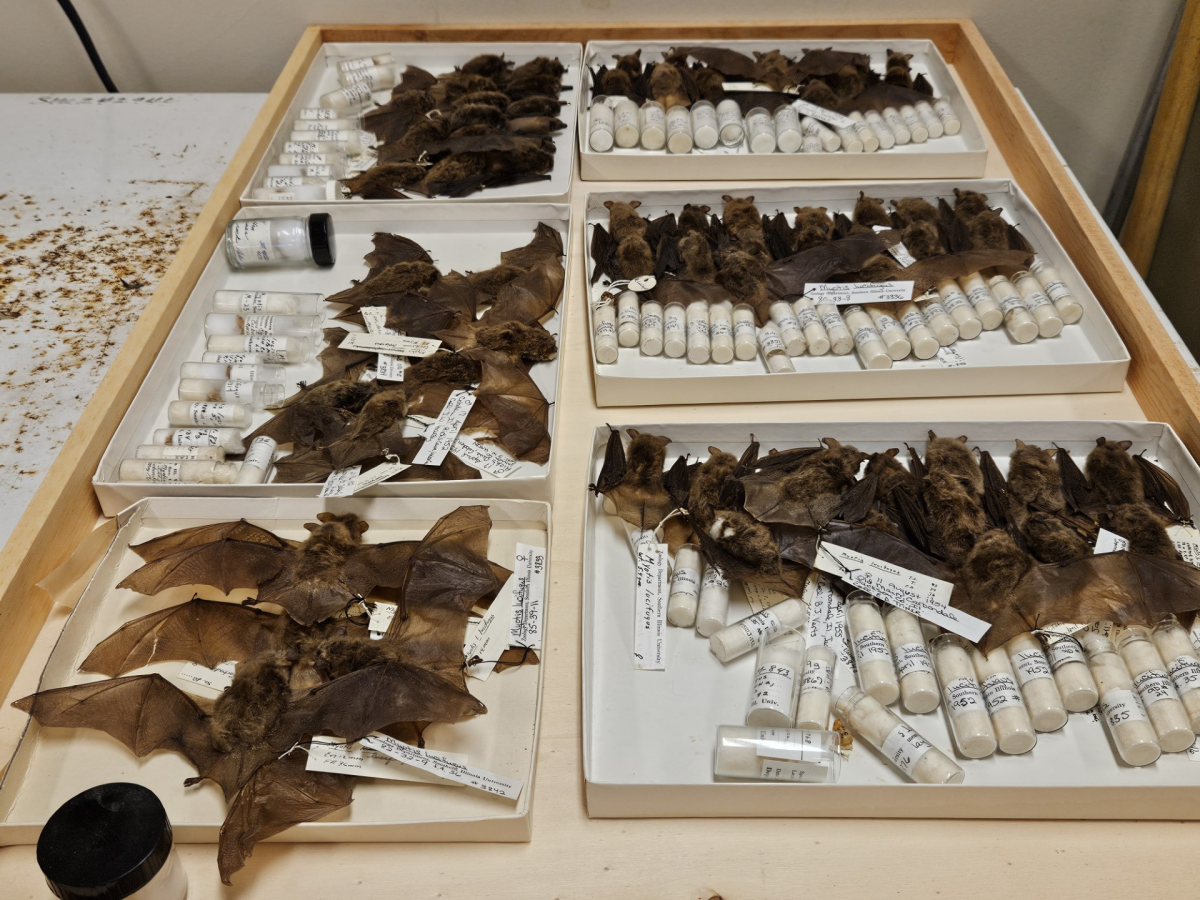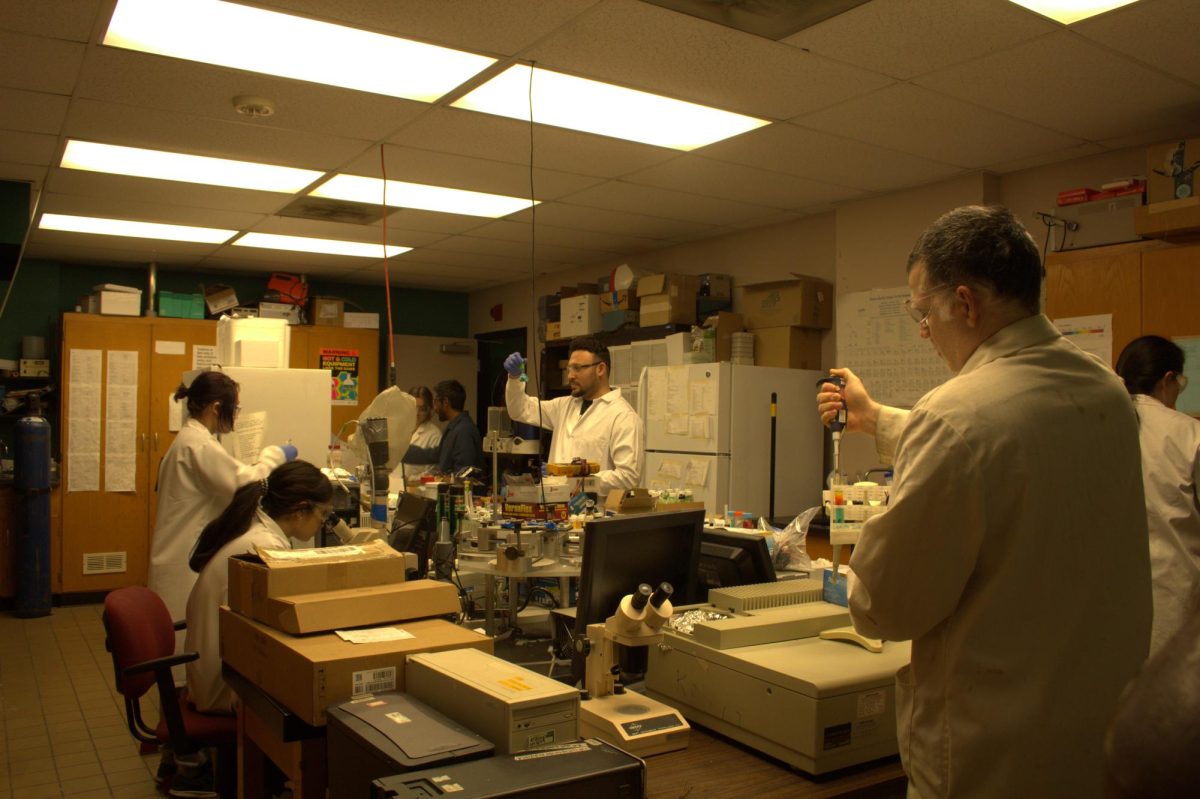Whether you love them or hate them, bats have always been an animal that people have strong opinions on. Public interest in bats has never been all that high, except possibly during the Halloween season. Everything changed for bats in 2020 when people all around the world began to take notice of this flying mammal in light of the COVID-19 pandemic. Now in 2024, interest in bats has waned. This is unfortunately because bats are still grossly misunderstood by the public.
Few people know that many species of bats in the United States are currently in danger of extinction due to a fungal disease known as white-nose syndrome (WNS)1. Most bats hibernate during the winter to save energy by lowering their body temperature and metabolic rates1. In bats with WNS, the fungus causes them to wake up much more often1. Each time they wake up, the bats have to use energy to increase their body temperature and metabolic rates1. This means that throughout the winter if they are woken up too frequently, it can result in the bats using up all their fat reserves and then potentially starving to death before winter ends1. WNS spread to the US in 2006 and since then it has killed millions of bats with some researchers predicting it will cause some regional groups of bats to go extinct1.
To get a better understanding of why we should care about bats and their decline along with how to get into bat research, I sat down to talk with the only current graduate student researching bats at SIU, Lexie Schwartz.
Advertisement
Interview highlights:
This interview has been edited for length and clarity.
Interviewer: Could you say what inspired you to go into researching bats?
Lexie Schwartz: Yeah, so a couple of years ago during my undergrad, I worked at a state park up in Minnesota called Forestville Mystery State Park which has a cave. When we were over there doing work at the cave, we started talking about bats. And then we were talking about white-nose syndrome and how they used to have thousands of bats in the cave. Caving was a big thing there. And so people would walk through the caves and there’d be tons of bats lying in the ceiling. White-nose syndrome pretty much killed them all. And it was really, really sad. And I guess I’ve always thought that bats were really cool. But then I was like, oh my gosh, I have an opportunity to really do some research that might make a difference.
Interviewer: Could you just describe what your research is and how you think it might help bats?
Schwartz: Yeah. So my research isn’t actually collecting data, which is really unfortunate because it would be really cool to go out there and catch bats. But basically I’m taking pre-existing data about different aspects of bat morphology, like jaw morphology, wing morphology, echolocation, and taking different aspects of like habitat and climate and insect abundance and trying to figure out what explains why bats eat what they do. And this is, I think it’s important, because anything we can do to really understand bats is helpful. And if you understand, you know, what habitat they need to forage in, or what aspects explain why they eat what they do, it’ll better help us to be able to conserve their habitat and their resources and all that.
Interviewer: Okay. Um, do you know how the data is originally collected at all, or any techniques on how to collect data on bats?
Advertisement*
Schwartz: A lot of it has actually been from when people did certain aspects of their own research and they caught bats and they would measure their wings or measure different aspects of their jaw. Some of it is taken from mammalogy museums as well and for insect abundance, we’re actually estimating from weather data around the country.
Interviewer: So would you say that is one of the reasons that mammalogy museums like the one we have at SIU are really important?
Schwartz: Yeah, a hundred percent.
Interviewer: Among the general public, a lot of people are really afraid of bats and they don’t understand them. Do you have any people that you’ve like encountered that have been like that? And what do you think is the best idea to address those concerns or to just get people to understand bats better?
Schwartz: A lot of my family is like that, which really sucks. I spend a lot of time at family events trying to get people to like bats. One of the things I do is kind of tell them how important they are. Um, so my family really likes tequila and so that’s, one of the ways I’m like, well, without bats, you can’t have tequila because they pollinate the agave plant.
Interviewer: Are they the only pollinator of agave?
Schwartz: Ah no, but they’re one of them. And you know, you take away one pollinator and that has a devastating effect on ecosystems. But another thing is just kind of telling them how important they are. Like a lot of people also really don’t like insects and bugs. So I kind of use that to my advantage. I definitely try to tell them about how many insects they consume. I found a really cool little fact the other day. From white-nose syndrome, there’s been millions of bats killed and so killing 1 million bats means that there are 660 to 1320 more metric tons of insects flying around each year that bats didn’t eat, which is crazy!
Interviewer: Yeah, that is really crazy! What would you say do you know what most research on bats is these days? Is it white-nose syndrome or is it just kind of a variety of everything?
Schwartz: Kind of a variety because not all bats are affected by white-nose syndrome. It’s more the cave hibernating bats.
Interviewer: Would you say the majority or the minority of bats are affected by white-nose syndrome?
Schwartz: I would probably say the majority. But there are a ton of bat species out there. So there’s quite a variety. I mean, habitat loss is a big thing that is harmful to them right now and so, they’re just losing a lot of places to roost, which is also killing some bats. Even if you’re researching fruit-eating bats they will disperse seeds. When we go and clear a rainforest, bats are actually one of the first animals that help regenerate because they are one of the first animals to disperse seeds which is pretty cool and important.
Interviewer: Do you think that COVID has impacted any of the bat research?
Schwartz: Yeah. I guess I’m not really sure. But I mean there was always some research into bat viruses because they can survive a lot of the viruses that will end up killing us. Definitely with COVID, more people are looking into COVID coming from bats, but also what other viruses that they may carry. People do a ton of research about different aspects of bats, like what they eat or how light pollution is affecting them.
Interviewer: What do you think are the most important reasons for protecting bats and why are they important for humans and the overall ecosystem?
Schwartz: Well especially in the United States, they’re like the most significant predator of flying insects which can have pretty devastating effects on crops and agriculture. For humans, especially that’s important. This kind of varies a little bit depending on who you ask, but every year they provide about $3 billion in ecosystem services to farmers in terms of crop damage and also reduce pesticide usage, which is pretty cool. Controlling insects really is just important for everything.
Interviewer: Besides benefits to humans, what would an abundance of insects do to the rest of the ecosystem?
Schwartz: I guess part of it too is like, you know, they eat our agricultural crops, but they will also eat other forms of vegetation. So if there’s too many insects, there’s not going to be enough food for other herbivores and then in turn not enough food, just like a whole food chain reaction.
Interviewer: Yeah that’s pretty important. So do you have any next steps in your research and do you think you’re going to be continuing to work on bats in the future?
Schwartz: I definitely think I will continue to work on bats in the future. I think they’re super cool and I don’t think enough people care about them. So that’s definitely motivation to keep working with them. But I don’t know exactly. I want to possibly continue doing research on bats maybe after my master’s, but I also kind of want a break. I definitely think it’d be really cool to work for Bat Conservation International so that might be something I pursue after this.
Interviewer: Well thanks so much for talking with me today. It was really interesting to hear more about your research and why bats are so important.
Schwartz: No problem, I’m always excited to talk about anything bat-related!
Advertisement






















